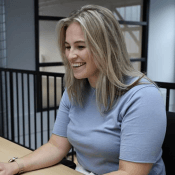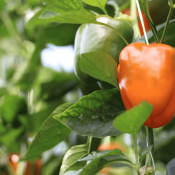Closing the data gap in horticultural research: in conversation with Chris Need
A few weeks ago, we spoke to horticultural consultant Chris Need about the role real-time data plays in helping growers prevent disease (in this specific case pansy mottle syndrome), and discussed how remote monitoring of plants and their environment can help drive more informed, immediate decision-making.
A few weeks (and a new product update) on, we’ve checked in again.
On the agenda this time: data as common ground for collaboration and innovation across teams and departments.
Now that you’re working with a crop data platform with your customers, what impact have you seen?
For communication between myself and the customer, the 30MHz platform has worked brilliantly. We see historical context, the current status of plants, and can make confident decisions based on a combination of live data and an understanding of what’s been going on previously. We’ve been able to take preventative measures to avoid disease in crops, while communicating from anywhere in the world.
I’m really enthusiastic for the opportunities for collaboration and data exchange that groups and comments offer customers as well. I see some growers taking the next step and forming interdisciplinary project groups within the nursery. These groups features— the ability to share sensor data with any stakeholder, and have an ongoing conversation about that live data– are powerful, so I’d like to see more of them!
Take the example of two growers I’m working with: one grows small plants, and then hands them over to the other. There’s no competition here. The growers work in separate buildings, at separate nurseries, and operatrate reasonably separately, but they’re part of the same chain— same ecosystem. And they happen to share the same overall management. A mutual understanding of the plants’ experience as they move from one stage to the next would be of great benefit to both growers, not to mention the plants themselves.
So how do growers move to this next level of digital collaboration?
(Well, they need to just log into the dashboard!)
In horticulture, everyone’s busy. And management at the top needs to see the impact on productivity and margins. Everyone wants innovation, but these organisations want to run as efficiently as possible— there isn’t a great deal of time for “free play.” That’s what makes 30MHz such a great fit: it’s easy to deploy and use, and the benefits are evident very quickly. It’s not risky for the business. That’s why it’s such a massive opportunity.
Working together to create horticultural strategies based on real, live data has tangible benefits. Even in extreme conditions— one of the hottest summers the UK has seen in years— we managed to produce a number of batches with no signs of pansy mottle syndrome (PaMS.) We looked at plant stress, environmental conditions, and took action. Screen settings and irrigation timings were manipulated to reduce leaf and air temperatures and reduce VPD peaks. 30MHz tech allowed us to go beyond a traditional approach of just looking at the environment— we could actually monitor the plants themselves and identify and minimise stress, something you wouldn’t spot using other tools.

At one point, something went wrong: very strong winds (over 15 m/s) led the climate computer to shut the vents based on thresholds set to prevent weather damage. High radiation and closed vents raised the temperature and VPD dramatically. Two weeks later, we saw that PaMS had developed. From my point of view, this experience confirmed that we had been taking the right approach to prevent pansy mottle syndrome to begin with. And if we didn’t take this approach, we would see the problem. We now have evidence to back our approach: we know we need to focus on what we need to control stress, and we see that if we don’t control those factors, we’ll have a negative result, with a delay of about two weeks. (We also know that changing wind speed settings will be able prevent this occurring in the future.)
So, we’ve already seen some great results, but granular real-time monitoring like this can have an impact in so many other areas of horticulture. There are real opportunities to leverage this kind of data to push forward on the R&D front— particularly in nurseries.

Traditionally, R&D is done in research stations, so there isn’t really access to commercial conditions. There aren’t opportunities to manipulate the environment or the plants the same day— technology like 30MHz closes this gap. I’ve seen pansy mottle trials with traditional data logging, where data was solely historic, and nothing could be improved in real-time. The environment simply couldn’t be manipulated quickly or effectively. What we’re doing at Newey Roundstone is the next step. The potential for responsive R&D in real, changing and changeable conditions is absolutely massive. I can’t wait to see the innovation that will come from collaborative, interdisciplinary collaboration based on live data. And it’s all possible in this platform.
Follow Chris’ views on the horticultural industry via LinkedIn, or contact him chris@needconsulting.co.uk


30MHz is typing… Our extended support team is ready to chat!
At 30MHz we think it’s important that our users can use our platform in an optimal way. At times you may have questions and you would like some help from our support team. Email and our support page filled with helpful articles were your go to’s. But we thought it was time for something extra… ...Read more
New 30MHz connect casing: How we protect your tech
To make sure your dataflow is fully protected, 30MHz introduces a new connect casing: waterproof, dust proof and even resistant to hits. This special shield will last longer and ensure a reliable dataflow from the connected sensor. What does that full protection mean? That’s what we will explain in this article. Watertight: resistant to wetness ...Read more
Smart assistant at work
After the launch of the smart (AI) assistant at GreenTech, the first growers have started using this new feature. The assistant helps them gain insights from their data faster and supports daily decision-making in the greenhouse. Growers report that they use the assistant for: Calculating differences in water content throughout the day Quickly identifying trends ...Read more


